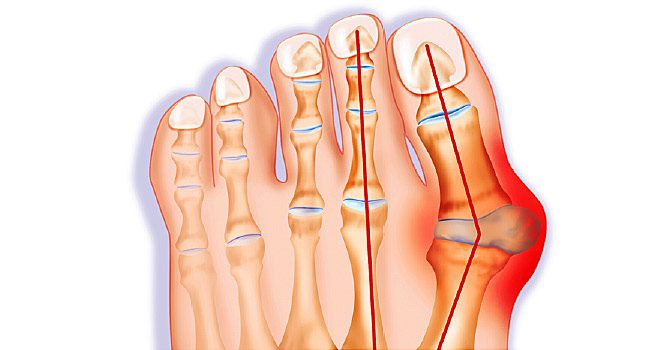What are Bunions?
Bunions often referred to as Hallux Valgus are bony bumps that develop on the inside of the foot at the big toe joint. The big toe is made up of two joints which is the Metatarsophalangeal joint (MTP) where the first long bone of the foot (Metatarsal) meets the first bone of the toe (Phalanx). Pressure on the big toe joint causes the big toe to lean toward the second toe. Over time, the normal structure of the bone changes resulting in the Bunion bump that develops at the MTP joint.
Symptoms of Bunions
Some common signs and symptoms of a bunion include a bulging bump on the outside of the base of the big toe, swelling, redness or soreness around the big toe joint, corns or calluses that often develop where the first and second toes rub against each other, ongoing pain or pain that comes and goes and limited movement of the big toe.
What causes Bunions?
Anyone can get a Bunion but they are more common in women as women commonly wear tight and narrow shoes that squeeze the toes together which makes it more likely for a Bunion to develop and cause painful symptoms. It can also be caused by inherited foot type and having an inflammatory condition such as rheumatoid arthritis or neuromuscular condition such as Polio. In some cases, care from an osteopath in Singapore may help address related biomechanical issues and provide symptom relief.
Bunions Treatment
Physical therapy can help with treating Bunions. Treatment of Bunions includes manual therapy, exercises, and patient education. The goal of treatment is to improve the function of the ankle, foot and toes, reduce pain and allow movement again. Manual therapy to improve strength and motion will be incorporated to gently move muscles and joints. To restore range of motion, stretches for the ankle, foot and toes will be taught. Personalised exercises will also be prescribed by your therapist to strengthen the muscles of the big toe and ankle as muscle imbalances or weaknesses in other parts of the body can contribute to Bunions and pain. If in doubt, please seek professional advice.
Osteopathic Approach to Bunion Management
Bunions can lead to discomfort, joint misalignment, and changes in foot mechanics over time. Learn more about how an osteopath in Singapore may support bunion-related concerns through non-invasive techniques aimed at improving alignment and relieving strain.
Check out our popular articles: Diastasis Recti, Tight Back Muscles, Irritable Bowel Syndrome (IBS), Temporomandibular Joint (TMJ) Dysfunction, Tennis Elbow, Wrist Tendon Injury, Sciatica, Whiplash, Hernia, Herniated Disc (Slipped Disc).






